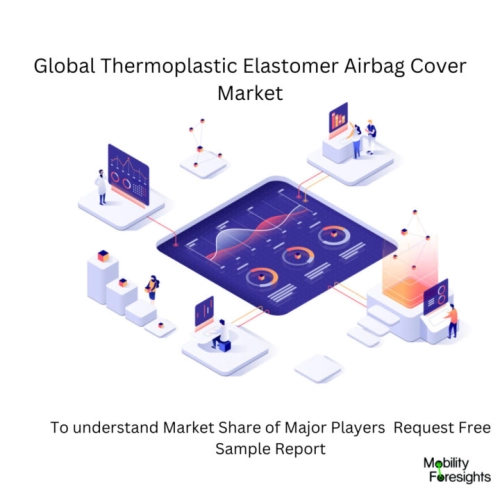
- Get in Touch with Us

Last Updated: Apr 25, 2025 | Study Period: 2023-2030
A component known as an "airbag cover" made of Thermoplastic Elastomers (TPE) covers airbag units used to protect passengers in automobiles.
TPE used for airbag covers must meet critical criteria like impact performance at low temperatures and durability to retain performance over a long period of time.
The demand characteristics for TPE for airbag cover applications have altered recently due to variations in the design and shape of airbags, which is in accordance with a growth in the types of vehicles equipped with airbags and in installation sites.

The Global Thermoplastic elastomer Airbag cover market accounted for $XX Billion in 2022 and is anticipated to reach $XX Billion by 2030, registering a CAGR of XX% from 2023 to 2030.
For airbag coverings, DuPont launched TPE made from renewable resources. The substance mimics the technical characteristics of the grade of Hytrel that is often employed for such applications, including consistent physical qualities across a large temperature range.
It is made from non-food biomass and has a minimum of 35% renewable content by weight, satisfying the demands of the automotive industry for environmentally friendly options.
Hytrel RS is based on a thermoplastic ether-ester elastomer (TPC-ET) with soft segments that contain a polyether made from non-food biomass and hard segments made of polybutylene terephthalate.
Hytrel DYM polymers derived from petroleum have been provided by DuPont to Takata-Petri, a prominent producer of cutting-edge occupant safety systems, for use in the driver and passenger airbag covers for various OEMs.
In line with this initiative, the two businesses set out to develop a new grade of Hytrel made from renewable resources that would perform on par with Hytrel DYM in terms of low-temperature ductility combined with high stiffness and good long-term ageing performance, as well as ease of processing and good paintability.
Hytrel RS was approved for use in Takata-serial Petri's production because the airbag covers it was used to mould met all of the company's technical specifications for paint adhesion, long-term ageing performance, and low temperature ductility, and because the prototypes of the product displayed remarkably similar behaviour when used in the airbag system.
| Sl no | Topic |
| 1 | Market Segmentation |
| 2 | Scope of the report |
| 3 | Abbreviations |
| 4 | Research Methodology |
| 5 | Executive Summary |
| 6 | Introduction |
| 7 | Insights from Industry stakeholders |
| 8 | Cost breakdown of Product by sub-components and average profit margin |
| 9 | Disruptive innovation in the Industry |
| 10 | Technology trends in the Industry |
| 11 | Consumer trends in the industry |
| 12 | Recent Production Milestones |
| 13 | Component Manufacturing in US, EU and China |
| 14 | COVID-19 impact on overall market |
| 15 | COVID-19 impact on Production of components |
| 16 | COVID-19 impact on Point of sale |
| 17 | Market Segmentation, Dynamics and Forecast by Geography, 2023-2030 |
| 18 | Market Segmentation, Dynamics and Forecast by Product Type, 2023-2030 |
| 19 | Market Segmentation, Dynamics and Forecast by Application, 2023-2030 |
| 20 | Market Segmentation, Dynamics and Forecast by End use, 2023-2030 |
| 21 | Product installation rate by OEM, 2023 |
| 22 | Incline/Decline in Average B-2-B selling price in past 5 years |
| 23 | Competition from substitute products |
| 24 | Gross margin and average profitability of suppliers |
| 25 | New product development in past 12 months |
| 26 | M&A in past 12 months |
| 27 | Growth strategy of leading players |
| 28 | Market share of vendors, 2023 |
| 29 | Company Profiles |
| 30 | Unmet needs and opportunity for new suppliers |
| 31 | Conclusion |
| 32 | Appendix |